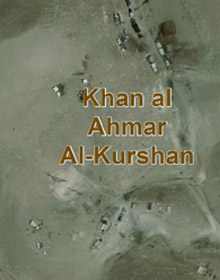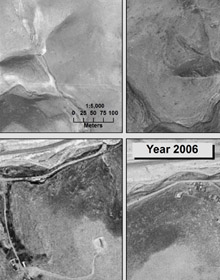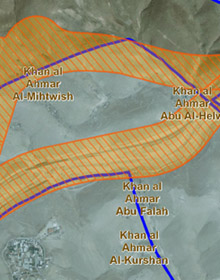 |
|||
|
The Bedouin Communities East of Jerusalem – A Planning Survey |
|||
|
●
Introduction Khan Al-Ahmar Communities ● Summary
|
16. Al-kurshan Community: Jahalin Tribe – Abu Dahuk family Population: 9 families, approx. 80 residents Water: Connected to water meter of the Mekorot Company Electricity: none Sewage: none Education: Elementary school in Abu Al-Helw Medical services: Mobile infirmary, twice monthly Daily necessities: Jericho Religious building: none Cemetery: Al-E’izariya Flocks: approximately 300 sheep
|
||
Identity Card |
Chronoligical Development  |
Planning Survey |
|
|
The Kurshan community is located east of Mishor Adumim, north of the industrial area and south of Road No. 1 leading to Jericho. It is part of the Al-Khan Al-Ahmar clusters and it has access to the clusters north of Road No. 1 via a dirt road that passes beneath it. Residents came to the area in the 1950s, following evacuation and deportation from Tel Arad, attracted to it by the availability of good grazing land. They settled there with the agreement of private land owners from Al-I’sawiyya. According to residents’ testimony, these areas served as seasonal grazing lands in winter, even before they settled there permanently. Permanent residence in the present location took root at a relatively late stage, following the reduction in grazing lands, options for mobility, and pressure placed on residents. Today, all of the lands there have been expropriated, as part of the expropriation in 1975, for the benefit of Ma’ale Adumim, and they are included in the jurisdictional area of the city and in the limits of its master plan. In the mid-1990s, a number of demolition orders were issued for buildings in Al-Kurshan, and according to residents’ testimonies, during that period a number of demolitions were carried out. Today, representatives of the Civil Administration visit regularly and prohibit any new building or additions to existing buildings, and last May, demolition orders were again issued, this time for 8 houses. The grazing areas around Al-Kurshan have been drastically reduced over the years, due to the proximity to the industrial area, army bases and closed military zones. Today, grazing is confined to the immediate vicinity of the houses, and the flocks serve only the domestic need of the residents. In winter, flocks are taken as far as the area of Tabaq Qtef, while in summer, they are taken by motor vehicle to the Beit Iksa area. Residents do not cultivate the land at all for agricultural crops. Children living in Al-Kurshan, the southernmost of the Al-Khan Al-Ahmar clusters, rarely attend the joint school in the Al-Helw cluster. Overall, the residents suffer from severe problems of access since the locality is cut off from the main road. Most of the residents, men and women alike, do not work at all outside of the locality with the exception of sheep herding. Main planning constraints: – Included within the limits of the development and expansion plans for Ma’ale Adumim – Expropriated lands lacking an accepted arrangement regarding ownership and usage rights – Included partially within the plan for a local road – Closed military areas near the locality Limitations on grazing lands and access to water sources |
|||